 |
 |





 |
 |
 |
 |
 |
 |
LRT rails in downtown Minneapolis recall city’s first rail transit system
|
 |
 |
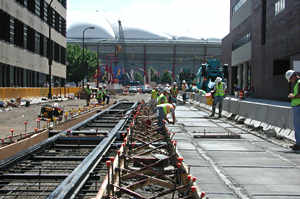 |
Rail tracks have returned to downtown Minneapolis after
more than 50 years as crews lay the first tracks for the Hiawatha Light
Rail Transit line. Photo by Josh Collins
|
Passenger rail tracks returned to downtown Minneapolis last week after an absence
of nearly 50 years. That’s when light rail construction crews laid the first
sections of track at the Portland Avenue-Fifth Street intersection for the Hiawatha
Light Rail Transit project. During the next few weeks, more rail line will be
installed as crews move west-by-northwest down Fifth Street to Hennepin Avenue.
Streetcars crisscrossed the Twin Cities and the downtown area until 1954, when
the system was dismantled. The recent resurgence of light rail generates a great
deal of public curiosity and excitement, said Josh Collins, Mn/DOT community
outreach specialist, Hiawatha Project Office.
"Walk the nine blocks of downtown at lunchtime where we’re building and
you’re sure to find dozens of people watching the progress," said Collins.
"This work has people talking. It’s amazing to see how excited people are
about this project."
The tracks for light rail in the downtown area will be embedded in concrete
to allow vehicles and pedestrians to cross at intersections easily.
The rest of the 11.6-mile long corridor is now a buzz of activity, Collins
said.
For more than a year, private utility companies have been relocating facilities
to prepare for LRT on Fifth Street in downtown; this work is almost complete.
South of downtown, crews have placed track from 11th Avenue to the bridge at
Lake Street. Right now, the design/build project is 48 percent complete. By
the end of the year, both the Lake Street Bridge and the Crosstown (Hwy 62)
bridges will be complete. Track will run from the Nicollet Mall all the way
to 50th Street in south Minneapolis.
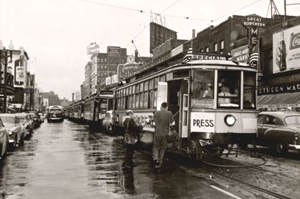 |
|
This last streetcar ran on the last section of track
in downtown Minneapolis in 1954. Photo courtesy of the Minneapolis
Public Library
|
The 2002 construction season will also see 12 of the 17 stations take shape.
Work continues at the same time on the LRT operations and maintenance facility
at Cedar Avenue just south of I-94. In addition, construction crews are on schedule
to turn the building over to Metro Transit during the first week of October.
Activity continues at the airport, where crews are digging the second tunnel
underneath the landing field. Crews completed the first tunnel in April and
expect to complete the second tunnel this fall.
LRT service will begin between the Nicollet Mall in downtown Minneapolis and
Fort Snelling in late 2003. In 2004, service will begin to the airport, Mall
of America and warehouse district.
"We are in the middle of the most significant construction season for
this project," said Commissioner Elwyn Tinklenberg. "The signs are
all around us; the public can clearly see that light-rail transit is becoming
a reality."
|
back

|
 |
Collaboration expands scope of state’s ‘living snow fence’ program
|
 |
 |
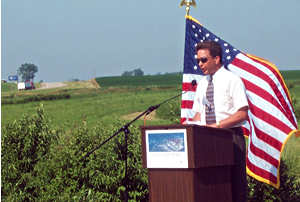 |
|
Mankato District Engineer Jon Huseby addresses participants
in Gibbon during the signing of an agreement by state and federal officials
to widen support for the living snow fence program. By Rebecca Arndt
|
State and federal government officials announced Tuesday the expansion of the
living snow fence program during ceremonies held in Gibbon, Minn., the site
of a two-year-old living snow fence on Hwy 19.
The program pays farmers and other landowners for designating part of their
land for living snow fences under the Conservation Reserve Program, part of
the 2002 Farm Bill.
The new agreement links Mn/DOT, the U.S. Department of Agriculture's Farm Service
Agency and Natural Resources Conservation Service and the Minnesota Association
of Soil and Water Conservation Districts.
Since 1998, Mn/DOT has worked with landowners to promote the program, encouraging
them to plant living snow fences along state highway locations that are problem
areas.
"Farmers can now receive payments under the Conservation Reserve Program as
well as support from Mn/DOT for living snow fences which save lives, money and
time by keeping highways open for travelers," said Commissioner Elwyn Tinklenberg.
"Besides being aesthetically pleasing, they are an environmentally sound solution
for making transportation safer and more efficient during Minnesota winters,"
he added.
Living snow fences use trees and shrubs located 150 feet to 300 feet from the
highway to trap blowing snow before it can collect in ditches or on the roadway.
Shrubs such as dogwood and lilacs are common choices for this type of program.
Dan Gullickson, program coordinator, Environmental Services, said that the
site in Gibbon shows how living snow fences can be incorporated into farming
operations.
"This stretch of Hwy 19 near Gibbon has closed a number of times in the
winter, but the living snow fence should keep the highway open in the future,"
he said. "We are identifying problem sections of state highways that are frequently
closed due to blowing and drifting snow. Our goal is to work with our partners
and encourage landowners to plant living snow fences."
Scientific research supports the creation of living snow fences.
"Recent winter field studies have shown that living snow fences can be a highly
effective method of controlling blowing and drifting snow on Minnesota roads
and highways," said Dr. Mark Seeley, a University of Minnesota climatologist.
"University of Minnesota climate research has shown that since pioneer settlement,
most areas of the state are witnessing an increase in annual snowfall. In this
context, it is imperative that some consideration be given to using living snow
fences," he added.
Check out the living snow fence Web site at www.livingsnowfence.dot.state.mn.us
for more information.
By Sue Stein
|
back

|
 |
Staff moves from Kelly Inn to cut lease costs, improve communication
|
 |
 |
Several offices will move from the Kelly Inn in St. Paul to the Transportation
Building to achieve optimal use of state-owned facilities and reduce building
lease costs. Mn/DOT will terminate the lease and vacate the Kelly Inn by Aug.
15.
Other changes include converting Conference Room G-13 into office space. In
addition to cutting costs, the moves will also improve communication among various
offices by grouping similar functions in their new locations.
The moves will affect 36 employees currently located on the ninth floor of
the Kelly Inn and save about $351,000 in costs for the lease that was to run
until June 2004.
Office moves that become effective Aug. 15 include:
-
Office of Electronic Communications, currently at the Kelly Inn, will be
relocated to the first floor of the Central Office building
-
Office of Environmental Services, currently located on the 6th floor of
the Central Office building, will be relocated to the 7th floor
-
Office of Technical Support, currently located on the 7th floor of the
Central Office building, will be relocated to the 6th floor
-
Office of Freight, Rail and Waterways, currently at the Kelly Inn, will
be relocated to the 7th floor, and a small group to the 6th floor, of the
Central Office building
-
Office of Passenger Rail will remain on the 7th floor of the Central Office
building
-
Part of the Office of Research on the first floor of the Central Office
building will be relocated to the Mn/DOT Library area on the same floor
-
Conference Room G-13 will be converted to include five workstations. This
space will be available for use by employees assigned to special projects,
temporary or emergency employees and those employees who may require shared
space. The latter group includes Seeds employees, employees on rotation
assignments and employees reporting only once or twice a week to the Central
Office building.
"Significant savings will be realized by terminating the lease with the Kelly
Inn," said Doug Weiszhaar, deputy commissioner. "However, I recognize that
this decision will cause some inconvenience in order to accomplish the resulting
office moves, especially within the limited time available. Some supervisors
and managers affected by the Kelly Inn moves may be required to move into non-private
office spaces until the completion of the second phase of change management."
Weiszhaar said every effort will be made throughout this project to minimize
the effects of moves and disruptions, employ existing standards for office space
requirements and consolidate the offices by location where possible.
Mail stops will remain the same for employees moving into the Transportation
Building and phone numbers will stay the same for most employees affected by
the moves.
"Because we are working within a very limited timeframe, I encourage you to
be as cooperative as possible with the Facility Management staff in order to
ensure the successful implementation of this relocation effort," said Weiszhaar.
|
back

|
 |
District, Metro context-sensitive design projects receive honors
|
 |
 |
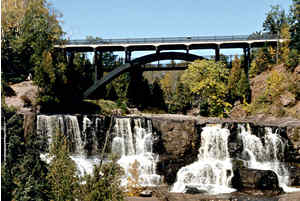 |
This new
Hwy 61 bridge over Gooseberry Falls integrates the highway
with the falls and Gooseberry Falls State Park. Photo by
Neil Kveberg
|
Mn/DOT’s CSD Steering Committee honored eight state projects and a workshop
that exemplify context-sensitive design principles in project development.
The Federal Highway Administration chose Minnesota and four other states to
lead development of CSD practices and training that can be shared with other
states and agencies.
The recognition honors one effort by each district and the Metro Division and
cites the Hwy 61 North Shore corridor that earned the "All-American Road" designation
among national scenic byways for its first daVinci Award.
Named for Renaissance artist, designer and engineer Leonardo daVinci, the award
cites excellence in design that harmonizes with the project’s natural, social,
environmental and cultural environments.
The scenic North Shore Hwy 61 corridor from Two Harbors to Grand Portage earned
the honor for its successful balance of transportation, environmental and community
values and for its objectives to link trade centers and connect tourists and
residents to the region’s natural and recreational assets while enhancing its
unique qualities and driving experience, said Scott Bradley, principal landscape
architect, Program Support.
"It’s our intent to provide annual recognition for the most noteworthy district
and Metro Division successes in applying CSD principles to projects that contribute
to design excellence and ‘Moving Minnesota’ safely and efficiently in with the
natural, economic and cultural environment," Bradley said.
District and Metro Division projects and initiatives honored include:
Duluth/District 1
The Piedmont Avenue project in Duluth incorporated input from citizens’ task
force to choose a design theme. The project includes a pedestrian underpass
and two bridges connecting two neighborhoods and incorporating historic themes
and detailing in Lincoln Park along the Skyline Drive into rebuilding Hwy 53
in the city. Rerouting Piedmont Avenue under the Skyline Parkway and over Miller
Creek will enhance the parkway by removing Hwy 53 traffic and allow future expansion
for bike and pedestrian trails along Miller Creek.
Bemidji/District 2
Recognized by the Federal Highway Administration for design excellence, the
redesigned Hwy 197 corridor through Bemidji combines more efficient traffic
movement with improved safety, access to businesses, aesthetics and respect
for cultural resources. The project’s successful blend of engineering and aesthetics
earned the FHWA’s Environmental Excellence Award for Livable Communities in
2001.
Brainerd/District 3
The new seven-mile section of Hwy 371 skirts the western edge of Brainerd,
reducing traffic congestion in the city and providing an attractive, well-designed
route that will eventually extend the Paul Bunyan trail through Baxter and connect
with Crow Wing State Park. The 371 bridge over the Mississippi River exemplifies
CSD with its use of native materials and depictions of native plants and wildlife.
 |
|
A decorative column at an entrance of the new Hwy 371
bridge near Baxter commemorates the area’s flora and fauna. Photo by
Neil Kveberg
|
Detroit Lakes/District 4
Hwy 29 (Third Avenue) in Alexandria represents cooperation between businesses
and government agencies to develop an access management plan along the route
(and the parallel Second Avenue) to accommodate utility improvements and business
access during construction. The project also includes paving an abandoned railroad
grade for a multi-use state trail. An adjacent park area will be developed as
a trailhead and future location of Big Ole, the city’s landmark Viking statute,
and the Kensington Runestone.
Rochester/District 6
A Hwy 61 corridor-specific workshop earned recognition as a model for promoting
CSD principles and considerations among stakeholders along the highway between
Red Wing and Wabasha. The workshop’s goals included reaching stakeholder concurrence
with CSD principles and to begin resolution of conflicts among competing priorities
and values.
Mankato/District 7
Construction of a new road alignment on Hwy 22 between Mankato and St. Peter
enhances community goals such as linkage and mobility while increasing access
for pedestrians and cyclists via coordination with area trail systems and improved
access on bridges between Kasota and St. Peter. Bridge-end pedestals and plazas
and other structural elements resemble the Kasota limestone quarried in the
area to reflect its regional significance.
The project used an external project advisory committee and a technical advisory
committee coupled with extensive public participation to resolve issues and
create "buy-in" for the design process.
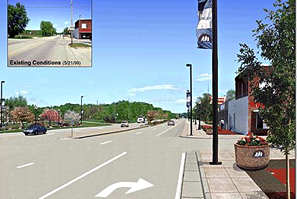 |
|
A computer visualization compares existing conditions
on Hwy 23 at Manitoba Avenue in Spicer with proposed design changes and
amenities. Illustration courtesy of Willmar/District 8
|
Willmar/District 8
The district’s plan for rebuilding an 11-mile section of Hwy 23 to four lanes
between Willmar and New London and through the city of Spicer earned recognition
for its strong efforts to balance safety and mobility with community and environmental
objectives. The project includes extensive public participation to protect the
corridor, including the city of Spicer and nearby Green Lake.
Roadway landscapes will reinforce a sense of place and identity in Spicer and
stringent measures are followed to minimize runoff and other impacts to Green
Lake under the guidance of the project’s water quality advisory committee.
Design elements include using form liners to simulate native field stone for
bridge abutments, retaining walls and other structures, and saving as many valued
trees and plantings as feasible while creating a more natural looking edge to
vegetation clearing limits in the area of rolling hillsides, wetlands and lakes.
Metro Division
Rebuilding Hwy 100 in Golden Valley, Crystal, Robbinsdale and Brooklyn Center
received recognition for reflecting the original corridor’s design through the
design detailing of bridges, structures and landscaping. The highway, once considered
the western suburban "beltway," was built during the 1930s through the federal
Works Progress Administration that hired unemployed people to build public facilities
during the Great Depression.
The project used a comprehensive aesthetic design process and a design guide
that incorporated wide participation by the public, governments and other stakeholders.
By Craig Wilkins
|
back

|
 |
Legislature creates changes in work zone safety regulations
|
 |
 |
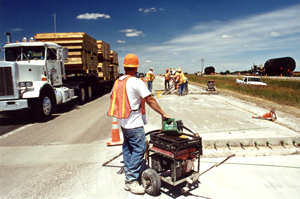 |
A new state
law requires posting speed limit signs in work zones such
as these. Photo by David Gonzalez
|
The Minnesota Legislature made several changes in laws related to work zone
safety during its 2001 session that now affect both motorists and highway workers.
In 2001, the Legislature defined that a work zone exists only when workers
are present at the site. This changes, for example, how construction projects
and other work zones are signed. For example, "Fines Double" signs are now required
to be placed on top of speed limit signs when workers are present and to be
removed when they are not.
In addition, the law requires posting signs denoting the specified lower speed
limit in the work zone.
The law also increases the maximum allowable speed limit in a highway work
zone to be 15 miles an hour slower than the posted speed on divided highways.
This means, for example, that the new speed limit in a 70 miles per hour zone
would be 55 miles per hour in a work zone.
However, the speed limit in work zones on two-lane roadways remains a maximum
of 40 miles per hour.
"The changes in the law will allow us to continue Moving Minnesota while maintaining
the safety of workers and the traveling public," said Dan Brannan, an engineering
specialist with the Office of Traffic Engineering.
In order to raise awareness of the need for greater work zone safety, Mn/DOT
continues its intense work zone safety message this spring and summer. Messages
conveyed via billboards, radio announcements and other media encourage motorists
to use extra caution in work zone for their safety and that of highway workers.
By Mary Meinert
|
back

|
 |
Finnish visitors teach as they learn during summer stay
|
 |
 |
 |
Finnish exchange worker Johanna Mäkinen
takes notes as Mike Mauren of the Traffic Management Center
talks about his experiences in broadcasting road conditions
on Twin Cities metro highways. Photo by Teresa Callies
|
Johanna Mäkinen and Anna Schirokoff are two young professionals whose
careers and interests in transportation have taken them to different parts of
the world. Mäkinen has spent the last academic year studying in Budapest,
Hungary; Schirokoff’s research in intelligent transportation systems has taken
her to Seoul, South Korea, and Sydney, Australia, for conferences.
This summer both are visiting Minnesota through Mn/DOT’s exchange program with
the Finnish National Road Administration.
Mäkinen is originally from Forssa, city of 20,000, just northwest of Helsinki.
She is currently working on a master’s degree in industrial economy from Tampere
University of Technology.
"I didn’t know what to do after high school, and I was interested in everything
– especially the economy. At university I took courses in everything from environmental
protection to quality management to project management. Everything fits together
nicely," she said. Mäkinen’s master’s thesis will be done in conjunction
with work she will do with the Finnish National Road Administration.
While at Mn/DOT, she is researching the economic impacts of traveler information
on logistics and freight movement.
Schirokoff, who has a master’s degree in traffic and transportation engineering,
is a research scientist with the Technical Research Centre of Finland near Helsinki.
She has worked on research projects that examine the effects of variable speed
limits and variable road lighting on driver behavior. During her time with Mn/DOT
she is learning everything she can about intelligent transportation systems,
particularly incident management.
Both women have attended meetings such as the recent American Association of
State Highway and Transportation Official’s on intelligent transportation engineering.
They will exchange ideas and expertise with transportation professionals at
the Center for Transportation Studies at the University of Minnesota.
Later this month they’ll visit the Bemidji District for meetings related to
traffic engineering operations in northern Minnesota.
They recently spent a week at the Traffic Management Center learning about
traffic operations as well as incident management. To gain first-hand experience,
both women went on early morning ride-alongs with Highway Helper staff, observed
rush hour activity in the control room and learned about traffic management
operations practices.
"The week at TMC fit in perfectly with my research," Schirokoff said. "I am
studying different methods of incident management around the world."
The amount of traffic in the Twin Cities and the number of freeways here surprised
both visitors. Helsinki and the surrounding area have about one million people,
they note. They added that Helsinki is laid out like the spokes of a wheel with
major freeways going around the city but not into the city center. Helsinki
also has comprehensive mass transit modes such as trams, buses and trains.
Glen Carlson, assistant division engineer, Metro Traffic Engineering, reflected
on their visit. "It’s mutually beneficial when transportation professionals
from other countries spend time with us because they can learn about our programs
and policies. We can also exchange information with them and learn about policies
and procedures in Finland."
"There’s a definite value in professional exchange opportunities with other
countries," added Ginny Crowson, coordinator of Mn/DOT’s Advanced Traveler Information
Systems and the 511 program.
"Visitors not only learn about our approaches to transportation challenges
here, but we also get the chance to learn about different approaches to the
same challenges," she added. "While Anna and Johanna are learning about incident
management and logistics in Minnesota, they’re also sharing with us the challenges
they face in Finland with these same issues."
By Teresa Callies, Traffic Management Center
|
back

|
|



